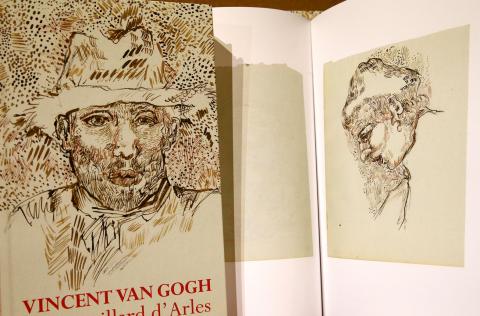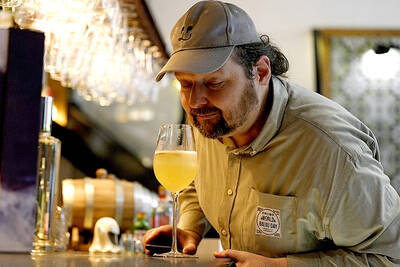Two scholars said Tuesday that they believe that an old sketchbook containing 65 drawings is an authentic work by Vincent van Gogh, and was created by that Post-Impressionist in Arles, France, where he made many of his famous and beloved paintings.
The scholars, Bogomila Welsh-Ovcharov, a University of Toronto professor emeritus of art history, and Ronald Pickvance, who has written two books on the artist, spoke as Welsh-Ovcharov announced the release of her book about the drawings, Vincent van Gogh: The Lost Arles Sketchbook.
But experts at the Van Gogh Museum in Amsterdam, which owns the largest collection of van Gogh artworks, immediately said that they disagreed with the scholars and that they view the drawings as most likely imitations by another artist.

Photo: REUTERS
“In our opinion, it’s not authentic,” said Louis van Tilborgh, a senior researcher at the Van Gogh Museum. “Owners of the sketchbook have asked our opinion in 2007 and 2012 again, and we studied the iconography, style and technique, and studied the provenance, and we came to the conclusion that it’s not by him. We have not changed our opinion.”
Van Tilborgh said, for example, that the drawings were made with brown ink, while van Gogh always worked with black or purple ink.
The announcement drew attention because Pickvance and Welsh-Orcharov are highly respected van Gogh scholars. Welsh-Ovcharov, 77, has curated exhibitions on van Gogh at the Musee d’Orsay in Paris and other museums. Pickvance organized two van Gogh exhibitions at the Metropolitan Museum of Art.
Pickvance said in a phone interview that there was no chance the book or the 65 drawings are forgeries. “These are absolutely OK, from one to 65,” he said. “End of song, end of story.”
Welsh-Ovcharov said that she first encountered the sketchbook in 2013, and spent three years tracking its history. She said that she believed the sketchbook had been given to the proprietors of the Cafe de Gare, a cafe and inn where van Gogh lived in Arles from May to early September 1888, by Felix Rey, a doctor who treated van Gogh. Not a typical artist’s sketchbook, it was a commercial ledger that Welsh-Ovcharov said had probably been given to van Gogh by the cafe’s owners, Joseph and Marie Ginoux, and was later returned by the doctor, filled with van Gogh’s creations, after the artist had been admitted to an asylum.
Welsh-Ovcharov said that this version of events was supported by a cafe’s employee datebook that she had reviewed and that has information on the cafe and the Ginoux family.
In an entry for May 20, 1890, the datebook says “Monsieur Doctor Rey left for M. and Mme. Ginoux from the painter Van Goghe [sic] some empty olive boxes and a bundle of checked towels as well as a large book of drawings and apologizes for the delay.”
The documents were later passed down to a Ginoux niece, Marguerite Crevoulin, according to Welsh-Ovcharov’s account.
Van Tilborgh said that he viewed the datebook as an “unreliable source.”
“The suggestion,” the museum said in a statement, “is that Rey had visited van Gogh in the asylum in Saint-Remy, but there is no evidence that this physician remained in contact with van Gogh at all after the latter’s admission to the asylum.”
Welsh-Ovcharov said the sketchbook remained with the Ginoux family until 1944. The sketchbook and the datebook were recovered from a Ginoux family home by a neighbor who did not know what they were, Welsh-Ovcharov said. The neighbor later gave the sketchbook to her daughter, the current owner, as a birthday present in the 1960s.
The current owner was not aware of what she had until someone suggested she take them to an expert, Welsh-Ovcharov said.
“These are very simple people and it was just by quirk of fate that they showed it to someone in the region who knew a local art specialist,” she said. “They took 30 of them and ripped them out of the book.”
The specialist, Franck Baille, an art historian and author from Aix-en-Provence who is director of a Monte Carlo auction house, then shared them with Welsh-Ovcharov, who has spent summers in Provence for the past 20 years.
“My first feeling was an incredible overwhelming feeling that I know what I have in my hands,” she said. “But then, of course, I knew I needed to do the scholarship.”
The sketchbook contains a portrait of van Gogh; sketches of Paul Gauguin; and sketches of the Yellow House, where van Gogh once lived; Langlois Bridge; seascapes at Saintes-Maries-de-la-Mer; and other major landmarks from paintings now among the artist’s most beloved artworks.
“Vincent van Gogh: The Lost Arles Sketchbook” is published in French by Editions de Seuil in Paris, and will be released simultaneously in English, German and Dutch, with other languages to follow. The English version is published by Abrams in Britain and the US.

The unexpected collapse of the recall campaigns is being viewed through many lenses, most of them skewed and self-absorbed. The international media unsurprisingly focuses on what they perceive as the message that Taiwanese voters were sending in the failure of the mass recall, especially to China, the US and to friendly Western nations. This made some sense prior to early last month. One of the main arguments used by recall campaigners for recalling Chinese Nationalist Party (KMT) lawmakers was that they were too pro-China, and by extension not to be trusted with defending the nation. Also by extension, that argument could be

Aug. 4 to Aug. 10 When Coca-Cola finally pushed its way into Taiwan’s market in 1968, it allegedly vowed to wipe out its major domestic rival Hey Song within five years. But Hey Song, which began as a manual operation in a family cow shed in 1925, had proven its resilience, surviving numerous setbacks — including the loss of autonomy and nearly all its assets due to the Japanese colonial government’s wartime economic policy. By the 1960s, Hey Song had risen to the top of Taiwan’s beverage industry. This success was driven not only by president Chang Wen-chi’s

Last week, on the heels of the recall election that turned out so badly for Taiwan, came the news that US President Donald Trump had blocked the transit of President William Lai (賴清德) through the US on his way to Latin America. A few days later the international media reported that in June a scheduled visit by Minister of National Defense Wellington Koo (顧立雄) for high level meetings was canceled by the US after China’s President Xi Jinping (習近平) asked Trump to curb US engagement with Taiwan during a June phone call. The cancellation of Lai’s transit was a gaudy

The centuries-old fiery Chinese spirit baijiu (白酒), long associated with business dinners, is being reshaped to appeal to younger generations as its makers adapt to changing times. Mostly distilled from sorghum, the clear but pungent liquor contains as much as 60 percent alcohol. It’s the usual choice for toasts of gan bei (乾杯), the Chinese expression for bottoms up, and raucous drinking games. “If you like to drink spirits and you’ve never had baijiu, it’s kind of like eating noodles but you’ve never had spaghetti,” said Jim Boyce, a Canadian writer and wine expert who founded World Baijiu Day a decade